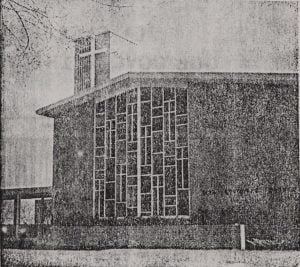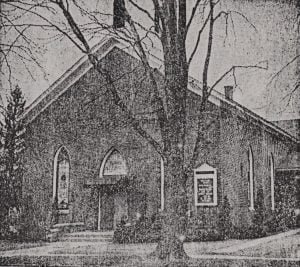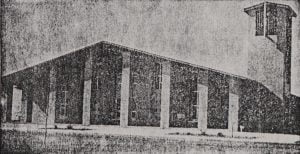This article explores the religious diversity and development within the early settlement of Richland, focusing on the Methodist, Lutheran, and Catholic communities. It highlights the initial absence of formal churches and how settlers maintained their faith through services held in homes or nearby established churches. The narrative emphasizes the significant role religion played in shaping the community’s identity, leading to the eventual establishment of organized congregations and the construction of the first church buildings. This historical reflection celebrates the perseverance and faith of Richland’s pioneers, whose efforts fostered a rich religious heritage and community spirit that continues to resonate today.
Church Bells in the Forest
by Lorenz H. Loesel
The early settlement of Richland and the varied background of our pioneering forefathers make a fascinating chapter in the annals of history. The Catholics, Lutherans, and Methodists in our community indicate that our culture and religious background stems from varying sources. This difference is not only reflected in different church bodies but the roster of names will reveal that our forefathers were of various nationalities. Obviously, these people brought with them their political beliefs, church affiliations, their native culture, native tongue, customs, ideals, prejudices, and many other basic traits which played a very significant role in the early and late development of our township.
We may well ask what motivated these good people to settle here at Richland and what caused them to leave their native country. Again, we are faced with many problems which are beyond the scope of this writer to answer and present all of the facts. However, we may assume that the settlement of this community followed the pattern of that of other communities. As we study the biographies of these pioneers, we find that many of them emigrated from Europe in the early 1850s. During those years, Europe was in the throes of famine, autocracy, revolutions, peasant labor, class distinction, and many other factors which contributed to great unrest among the populace. The rights of the common man were almost unknown. Constitutional government was still in its infancy. Landownership, equal rights before law, and other civil rights were restricted so that the average man looked to the western horizon which promised him a better future.
In order to acquaint these potential immigrants of Europe with the opportunities that could be enjoyed in the New World, a regular pamphlet was issued in the German and English languages. This pamphlet was accompanied by a map of Michigan, with the entire route laid down from New York to the termination of the Michigan Central Railroad. This booklet was distributed in the ports of Great Britain and Ireland as well as those of the Continent. This report was titled, The Emigrant’s Guide to the State of Michigan. It contained a general history of the State, its various soils, its agricultural and commercial advantages, a tabular statement of the exports and imports of the state during the commercial year of 1847. To this was added a general synopsis of the donation by the Congress of the United States to the State of Michigan of 500,000 acres of land. Furthermore, it contained those provisions of the constitution relative to education, and set forth the organic law on the subject of common schools and the state university. A table of rates at which foreign money or currency is taken at the custom house by act of Congress and the routes pointed out to the emigrant who sought a settlement within our state, with costs of transportation. (1)
Many of our pioneering parents read this report and were influenced by its promise of a better life in the New World. This can be deduced from the following report: “The Board of Supervisors of the county of Saginaw, with commendable zeal, appropriated $227 for adding to the pamphlet… the benefits arising from so small an appropriation have been returned to the county of Saginaw tenfold. In this county and that of Tuscola, attached to it for judicial purposes, several hundred persons have been added to the population, and upwards of twenty thousand acres of state lands have been purchased within the last ninety days for actual settlers… Arrangements have been made by Franklin Millard to run a propeller (boat) suitable for cabin and steerage passengers, once every ten days from Buffalo to Saginaw, where a small river steamboat will take them a considerable distance up either to Flint, Cass, Shiawassee or Tittabawassee rivers, and in the immediate vicinity of established settlements.” (2)
There is no doubt that this report helped to bring many of the Irish, Germans, English, Swiss, Scots, and other continentals to our immediate vicinity. In addition, many of our families left the state of Ohio and came to seek new and virgin soil in Michigan. French-Canadians also added to the ever-growing number of settlers in Richland. These were the people who were to establish our township government, schools, churches, and other institutions which have become an integral part of our community life. Inadvertently, we come to the basic thought that permeates the life of people — religion.
Most of these people had a religious background when they came to this country. However, when these pioneers had to clear the forests, build roads, build homes, and other tasks, it may seem to us that their religious life was obscured due to the heavy demands that were made on them. Since there was no organized church in Richland Township prior to the 1880s, we may well ask what guided their religious life from the early 1860s. Who took care of their spiritual needs, such as burials, marriages, baptisms, and similar activities, which are generally the function of the church. If we study the records of our community and surrounding areas, we find that the answer lies in the records of early established churches in Saginaw, Bay City, Lee’s Corner, and other communities.
Permit me to quote an observer of Richland Township and its people in the 1880s and note how he measures the spiritual life of our community. “The people generally profess Christianity. However varied in form these professions may be, all have studied to live together in peace and banish from their midst the demon of bigotry. The German Lutherans possess the one church building—the only duly organized congregation. The land upon which this church stands was presented to the Lutherans by Frederick Fitting.” (3)
It is not my aim or purpose to give an entire account of each church in our community because each church has issued an anniversary pamphlet which gives the complete history of their respective organizations. On the other hand, we will concern ourselves primarily with the years when these church bodies had no duly organized congregation. This period is extremely important since it did much to shape and mold the future development of the churches in our midst.
It is not too difficult to trace the history of Methodism in Richland Township when we study the early records of a neighboring village. Lee’s Corner, more commonly known today as Laporte, had religious services as early as 1856. This early date of 1856 predates the founding of Richland Township by six years. From conversations and reading of old records, I discovered that many of the pioneering Methodists in and around Richland were served by this church. This is also substantiated by the following history of the Laporte Methodist Church. “The first religious services in the Laporte neighborhood were held in the home of Earl Chamberlin. The log house where these meetings were held was still standing until about three years ago. It was one mile south of Laporte and about half a mile east. The Chamberlin home was always open for services and also a home for pastors, as was the home of William Cross. (I may add that the writer of this paper recalls this log cabin. This house was on the northwest corner where the Midland and Pruess roads intersect.)
At the Annual Conference held at Flint in 1855, Rev. William Tuttle was appointed to the Midland Mission, the first preacher to be sent among the white on both sides of the Tittabawassee River. The circuit extended from Midland to Shields and was visited several times by Mr. Tuttle also by
Rev. John Livingston from Saginaw. No class was formed here until later. Rev. Tuttle was followed by Rev. Crane, who formed the first class in 1858. The charge was known as the Swan Creek and Hemlock Circuit. Rev. Samuel Clements was the presiding Elder.” (May I add that the name of Hemlock Circuit must have been a name that was added later in the church records since there was no Hemlock existing at such an early date.)
Sometime during the late 60s or the early 70s, there arose a difference of opinion as to the site for a church and a number withdrew and formed themselves into a society after the order of the Wesleyan and took that name.
The first pastor appointed to this charge, of whom we have any record is Rev. William Tuttle, appointed by the conference in Ann Arbor. September 3, 1873, the circuit had been divided at the river and Mr. Tuttle had only a small charge, Hemlock City, Grove School House, Swan Creek, and Shields.” (4) The transition from this period of circuit riders to the actual building of a house of worship at Hemlock City is difficult to trace due to a lack of written records. According to the late William Earl, a certain Rev. Carson was the first actual resident preacher who preached in and around Hemlock City. Mr. Earl recalled when the first Methodist Church was built at Hemlock. He related to the undersigned that the logs for this first Wesleyan Methodist Church were taken from the Merrill Farm or the present site of Carl Hegenauer’s Golf Course. Even though Rev. Carson was not an officially ordained minister of this church, it was mainly through his effort and leadership that an active church life developed. Apparently, Mr. Earl’s statement is also substantiated by a letter written by Mrs. Delia (McLean) Morningstar: “Before the Methodist Church was built, a young man by the name of Carson, who lived back of the cemetery, went about the village preaching to small groups of people. The enthusiasm of the young man inspired the young men of the village to cut logs and haul them to the sawmill to saw lumber for the construction of a new church.” (5) This building mentioned in the previous paragraph is still standing and is being used as a storage place by the Hemlock Farmers Co-op. We may assume that this first church was built in the late 80s. Later this building was discontinued for services and a new church was built known as the Hemlock Methodist E. Church. If a reader wishes to acquaint himself with the entire history of this church, a complete story of the Hemlock Methodist E. Church is available at the Richland Township Library. Lutheranism in Richland Township followed a similar course as we noted in the growth of Methodism. Since there was no organized church body till the year of 1880, we must assume that the early Lutherans were served by other churches in Saginaw, Bay City, and Amelith. There were two Lutheran churches in Saginaw City known as Holy Cross Lutheran and St. Paul’s Evangelical Lutheran. Both churches were founded as early as 1849 and 1851 respectively. Many of the early Lutheran settlers of this area attended services at these churches. We must bear in mind that this refers to the period of the early 60s through to the late 70s. A similar account is found in the History of St. Peter’s Ev. Lutheran Church: “The first Lutherans settled in this region during the early seventies of the last century. But since they were few in number, they did not think of organizing a church but went to Saginaw for baptisms, marriages, and the like. About the year of 1878, several families, who had been members of Lutheran Churches in Macomb County, made their homes in the vicinity. Soon after this, Rev. J. F. Mueller of Amelith (near Bay City) while serving some of his faith in Wheeler, heard of the spiritual need of the Germans here.
He promptly looked them up and to their great joy preached the Gospel to them. Services were held by him and Rev. Joseph Schmidt of Holy Cross Lutheran Church of Saginaw. These two men conducted services in the Lunney School and in the homes of people. On March 29, 1880, this congregation was organized by accepting its present constitution.” (6)
By virtue of circumstances and necessity, the Catholics in this community were served by older churches that had been established in Midland and Saginaw. Their spiritual leaders were greatly concerned about the welfare and needs of their members. Consequently, we find their early history in the St. Mary’s Church Dedication Booklet as follows: “The first Catholics of the Hemlock area attended Mass and received the Sacraments at St. Andrew’s Church in Saginaw and St. Brigid’s Church in Midland prior to the year 1884. On September 2, 1884, the Rt. Rev. H. J. Richter, Bishop of Grand Rapids, dedicated St. Mary’s Church of Hemlock. Father Rainard Vander Heyden, pastor of St. Andrew’s, and Father Thomas McNamara of St. Brigid’s in Midland. The original congregation was made up of about forty Catholic families.” (7)
Studying the accounts of the Methodists, Lutherans, and Catholics, we find that their members were served first by established churches in nearby communities and later by regular circuit riders who would serve these people in their homes. We can readily see that our background and development paralleled the pattern of many other American communities. As we review the history of our beloved churches in our community, we are reminded of the influence they have in our daily life and community at large. Knowingly and unknowingly, they play a definite part in shaping the morals, ethics, arts, education, culture, and other related areas.
The bells of our churches which call us to worship are truly a symbol of Christianity in a community. We certainly owe a debt of gratitude to our forefathers who mounted the first bells in our community and established these treasured institutions in our midst. May we ever strive to perpetuate this heritage so that these bells will never become muted or lose their symbolic meaning.
Richland Township Church Images




References
- Part one taken from the Thompson Report.
- Early settlements Vol. 1 W. W. Florer, Ph.D.
- History of Saginaw County, Michigan, 1881.
- 1880-1930 Fiftieth Anniversary of St. Peter’s Evangelical Lutheran Church. Near Hemlock, Michigan.
- Letter written by Mrs. Delia Morningstar, Richland Township Library.
- History of Hemlock Methodist Church, Richland Twp. Library
- St. Mary’s Dedication, August 15, 1960, Hemlock, Michigan, Richland Township Library.
